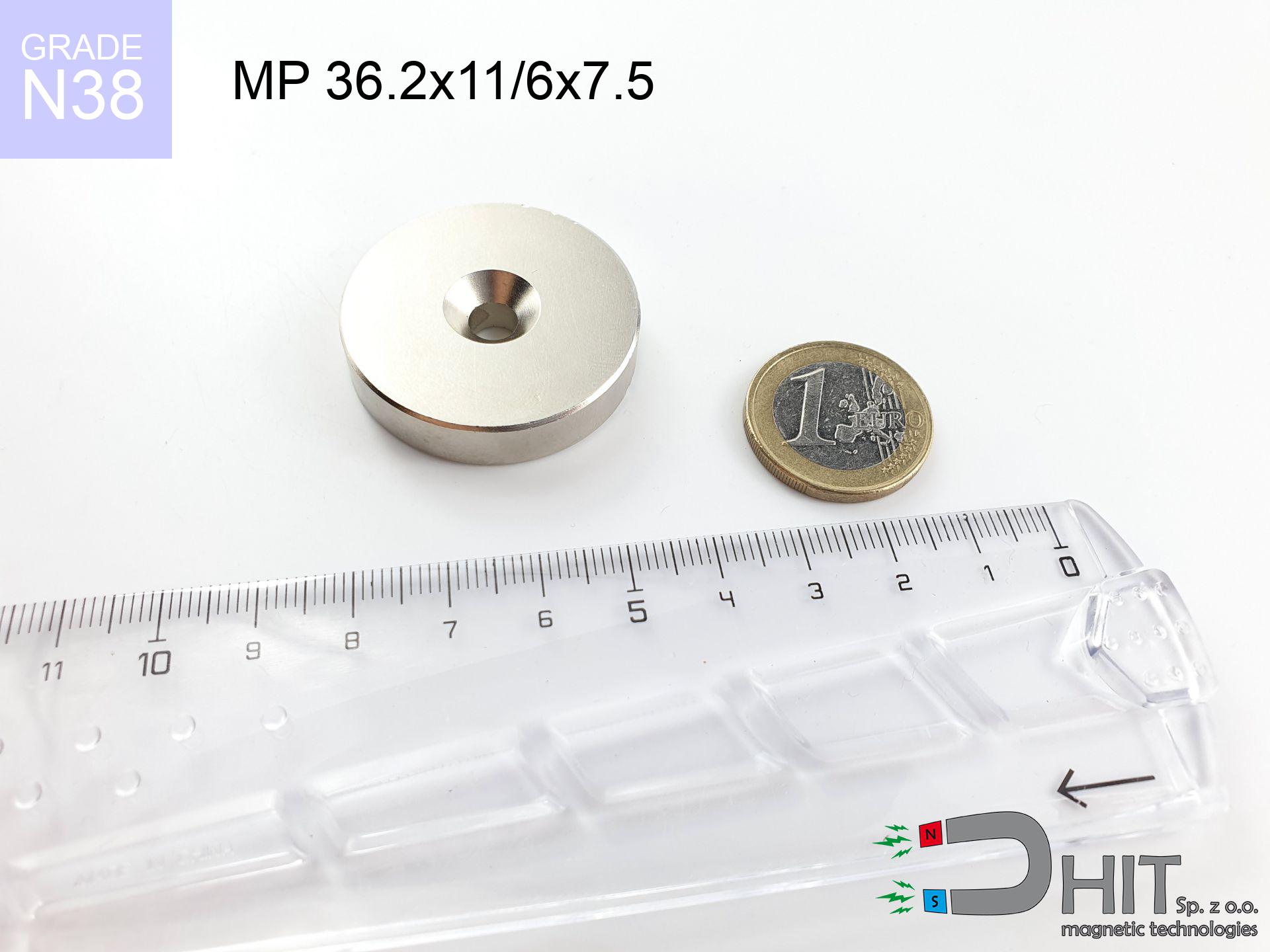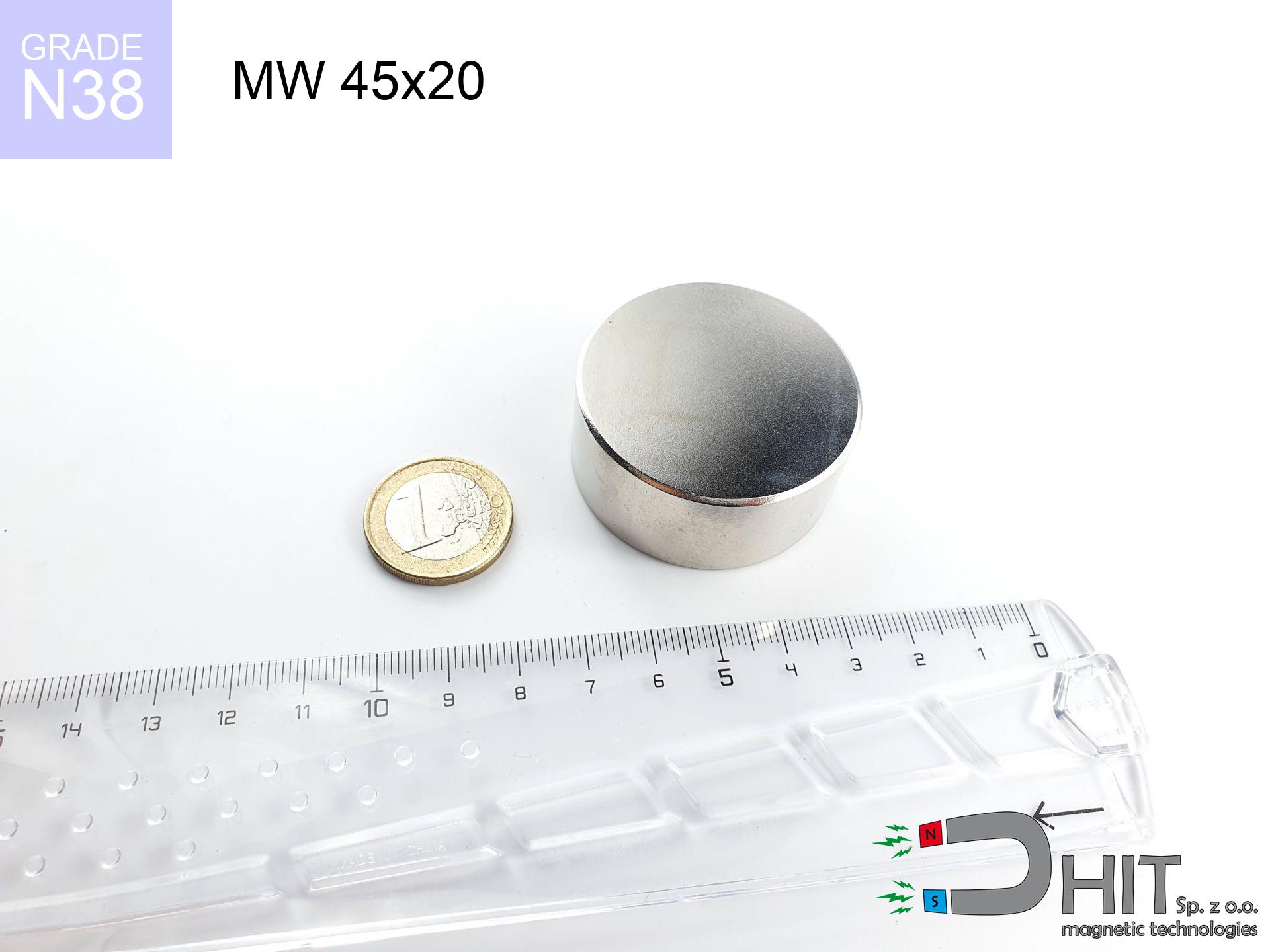UMP 135x40 [M10+M12] GW F 600 kg / N38 - search holder
search holder
Catalog no 210339
GTIN/EAN: 5906301813989
Diameter Ø
135 mm [±1 mm]
Height
40 mm [±1 mm]
Weight
4300 g
Load capacity
680.00 kg / 6668.52 N
Coating
[NiCuNi] Nickel
Magnetic Flux
~ 10 000 Gauss [±5%]
599.99 ZŁ with VAT / pcs + price for transport
487.80 ZŁ net + 23% VAT / pcs
bulk discounts:
Need more?
Give us a call
+48 22 499 98 98
otherwise send us a note through
our online form
the contact page.
Strength as well as form of a magnet can be calculated using our
magnetic mass calculator.
Same-day shipping for orders placed before 14:00.
💡 Check why professionals choose Dhit over cheap substitutes
Don't be fooled by amateur online tests – go for certified quality and specific parameters that guarantee success:
- 📏 Magnet thickness in the casing (min. 10mm) – This is what matters most! Thin magnets are weak. Thanks to the 1cm thickness of N52 neodymium, your magnet "sees" metal even through thick rust and mud.
- 🛡️ Armored protection (Black Epoxy) – Forget about rust. This coating doesn't chip when hitting rocks and protects the magnet in water much better than regular nickel, which fails quickly.
- 🧲 Eyelets that don't steal power – Made of special non-magnetic steel, so they don't stick to the magnet and don't block the force. Important: mount only one eyelet at a time! Using 3 at once is a mistake that weakens the magnet.
- 🧶 Certified rope (min. 8mm) – You gain the certainty that your gear won't stay at the bottom. It's thick and comfortable, so it doesn't cut your fingers when pulling out heavy scrap metal.
- 🚀 Our advantage: We are the only ones combining the strongest N52 neodymium (10mm thick) with non-magnetic eyelets. This is real power and durability you won't find anywhere else.
Invest in solid equipment and enjoy the results!
Physical properties - UMP 135x40 [M10+M12] GW F 600 kg / N38 - search holder
Specification / characteristics - UMP 135x40 [M10+M12] GW F 600 kg / N38 - search holder
| properties | values |
|---|---|
| Cat. no. | 210339 |
| GTIN/EAN | 5906301813989 |
| Production/Distribution | Dhit sp. z o.o. |
| Country of origin | Poland / China / Germany |
| Customs code | 85059029 |
| Diameter Ø | 135 mm [±1 mm] |
| Height | 40 mm [±1 mm] |
| Weight | 4300 g |
| Load capacity ~ ? | 680.00 kg / 6668.52 N |
| Coating | [NiCuNi] Nickel |
| Holder Type | 2 sided |
| Material Type | Structural steel S235 (ferrous) |
| Magnetic Flux | ~ 10 000 Gauss [±5%] |
| Size/Mount Quantity | 2xM10/1xM12 |
| Manufacturing Tolerance | ±1 mm |
Magnetic properties of material N38
| properties | values | units |
|---|---|---|
| remenance Br [min. - max.] ? | 12.2-12.6 | kGs |
| remenance Br [min. - max.] ? | 1220-1260 | mT |
| coercivity bHc ? | 10.8-11.5 | kOe |
| coercivity bHc ? | 860-915 | kA/m |
| actual internal force iHc | ≥ 12 | kOe |
| actual internal force iHc | ≥ 955 | kA/m |
| energy density [min. - max.] ? | 36-38 | BH max MGOe |
| energy density [min. - max.] ? | 287-303 | BH max KJ/m |
| max. temperature ? | ≤ 80 | °C |
Physical properties of sintered neodymium magnets Nd2Fe14B at 20°C
| properties | values | units |
|---|---|---|
| Vickers hardness | ≥550 | Hv |
| Density | ≥7.4 | g/cm3 |
| Curie Temperature TC | 312 - 380 | °C |
| Curie Temperature TF | 593 - 716 | °F |
| Specific resistance | 150 | μΩ⋅cm |
| Bending strength | 250 | MPa |
| Compressive strength | 1000~1100 | MPa |
| Thermal expansion parallel (∥) to orientation (M) | (3-4) x 10-6 | °C-1 |
| Thermal expansion perpendicular (⊥) to orientation (M) | -(1-3) x 10-6 | °C-1 |
| Young's modulus | 1.7 x 104 | kg/mm² |
Material specification
| iron (Fe) | 64% – 68% |
| neodymium (Nd) | 29% – 32% |
| boron (B) | 1.1% – 1.2% |
| dysprosium (Dy) | 0.5% – 2.0% |
| coating (Ni-Cu-Ni) | < 0.05% |
Environmental data
| recyclability (EoL) | 100% |
| recycled raw materials | ~10% (pre-cons) |
| carbon footprint | low / zredukowany |
| waste code (EWC) | 16 02 16 |
Check out more proposals
Strengths as well as weaknesses of rare earth magnets.
Pros
- They do not lose power, even after around 10 years – the reduction in strength is only ~1% (based on measurements),
- They are resistant to demagnetization induced by external magnetic fields,
- A magnet with a shiny silver surface looks better,
- The surface of neodymium magnets generates a maximum magnetic field – this is a key feature,
- Thanks to resistance to high temperature, they can operate (depending on the shape) even at temperatures up to 230°C and higher...
- Possibility of individual forming and modifying to precise needs,
- Significant place in electronics industry – they serve a role in hard drives, electric motors, precision medical tools, as well as technologically advanced constructions.
- Relatively small size with high pulling force – neodymium magnets offer strong magnetic field in tiny dimensions, which makes them useful in small systems
Disadvantages
- Susceptibility to cracking is one of their disadvantages. Upon strong impact they can fracture. We advise keeping them in a special holder, which not only protects them against impacts but also raises their durability
- We warn that neodymium magnets can lose their strength at high temperatures. To prevent this, we recommend our specialized [AH] magnets, which work effectively even at 230°C.
- Due to the susceptibility of magnets to corrosion in a humid environment, we suggest using waterproof magnets made of rubber, plastic or other material stable to moisture, when using outdoors
- Limited ability of making threads in the magnet and complicated shapes - preferred is a housing - magnetic holder.
- Health risk resulting from small fragments of magnets are risky, when accidentally swallowed, which gains importance in the context of child safety. Additionally, tiny parts of these devices can be problematic in diagnostics medical in case of swallowing.
- Due to neodymium price, their price is relatively high,
Holding force characteristics
Maximum lifting force for a neodymium magnet – what it depends on?
- with the application of a yoke made of special test steel, ensuring maximum field concentration
- with a thickness of at least 10 mm
- with an ideally smooth contact surface
- without the slightest air gap between the magnet and steel
- during detachment in a direction vertical to the mounting surface
- in stable room temperature
What influences lifting capacity in practice
- Clearance – existence of foreign body (rust, dirt, air) interrupts the magnetic circuit, which reduces power rapidly (even by 50% at 0.5 mm).
- Direction of force – highest force is obtained only during pulling at a 90° angle. The resistance to sliding of the magnet along the plate is typically many times lower (approx. 1/5 of the lifting capacity).
- Metal thickness – thin material does not allow full use of the magnet. Magnetic flux passes through the material instead of generating force.
- Chemical composition of the base – mild steel gives the best results. Higher carbon content decrease magnetic properties and lifting capacity.
- Surface finish – full contact is possible only on polished steel. Rough texture reduce the real contact area, reducing force.
- Thermal environment – temperature increase causes a temporary drop of induction. Check the thermal limit for a given model.
Lifting capacity testing was carried out on plates with a smooth surface of optimal thickness, under perpendicular forces, whereas under parallel forces the load capacity is reduced by as much as 5 times. In addition, even a slight gap between the magnet’s surface and the plate decreases the holding force.
H&S for magnets
Allergic reactions
Studies show that the nickel plating (standard magnet coating) is a strong allergen. If you have an allergy, prevent touching magnets with bare hands or opt for coated magnets.
Magnet fragility
NdFeB magnets are ceramic materials, which means they are prone to chipping. Collision of two magnets will cause them breaking into small pieces.
Life threat
Warning for patients: Strong magnetic fields affect electronics. Keep minimum 30 cm distance or request help to work with the magnets.
Operating temperature
Standard neodymium magnets (N-type) lose power when the temperature goes above 80°C. Damage is permanent.
Electronic devices
Powerful magnetic fields can corrupt files on payment cards, HDDs, and other magnetic media. Maintain a gap of min. 10 cm.
Machining danger
Mechanical processing of NdFeB material poses a fire risk. Neodymium dust oxidizes rapidly with oxygen and is hard to extinguish.
Pinching danger
Danger of trauma: The pulling power is so immense that it can cause blood blisters, crushing, and broken bones. Use thick gloves.
Magnetic interference
GPS units and smartphones are highly sensitive to magnetic fields. Direct contact with a powerful NdFeB magnet can ruin the internal compass in your phone.
This is not a toy
Always store magnets out of reach of children. Choking hazard is high, and the consequences of magnets connecting inside the body are very dangerous.
Do not underestimate power
Handle magnets consciously. Their powerful strength can shock even experienced users. Plan your moves and do not underestimate their power.

![Search magnet UMP 135x40 [M10+M12] GW F 600 kg / N38 - GOLD Series Search magnet UMP 135x40 [M10+M12] GW F 600 kg / N38 - GOLD Series](https://cdn3.dhit.pl/graphics/banners/magnet.webp)
![UMP 135x40 [M10+M12] GW F 600 kg / N38 - search holder](https://cdn3.dhit.pl/graphics/products/ump135x40-m10+m12-gw-f-600-kg-luz.jpg)


![UMGGW 34x8 [M4] GW / N38 - magnetic holder rubber internal thread UMGGW 34x8 [M4] GW / N38 - magnetic holder rubber internal thread](https://cdn3.dhit.pl/graphics/products/umg-34x8-m4-gw-kek.jpg)
![SM 25x175 [2xM8] / N42 - magnetic separator SM 25x175 [2xM8] / N42 - magnetic separator](https://cdn3.dhit.pl/graphics/products/sm-25x175-2xm8-fux.jpg)

